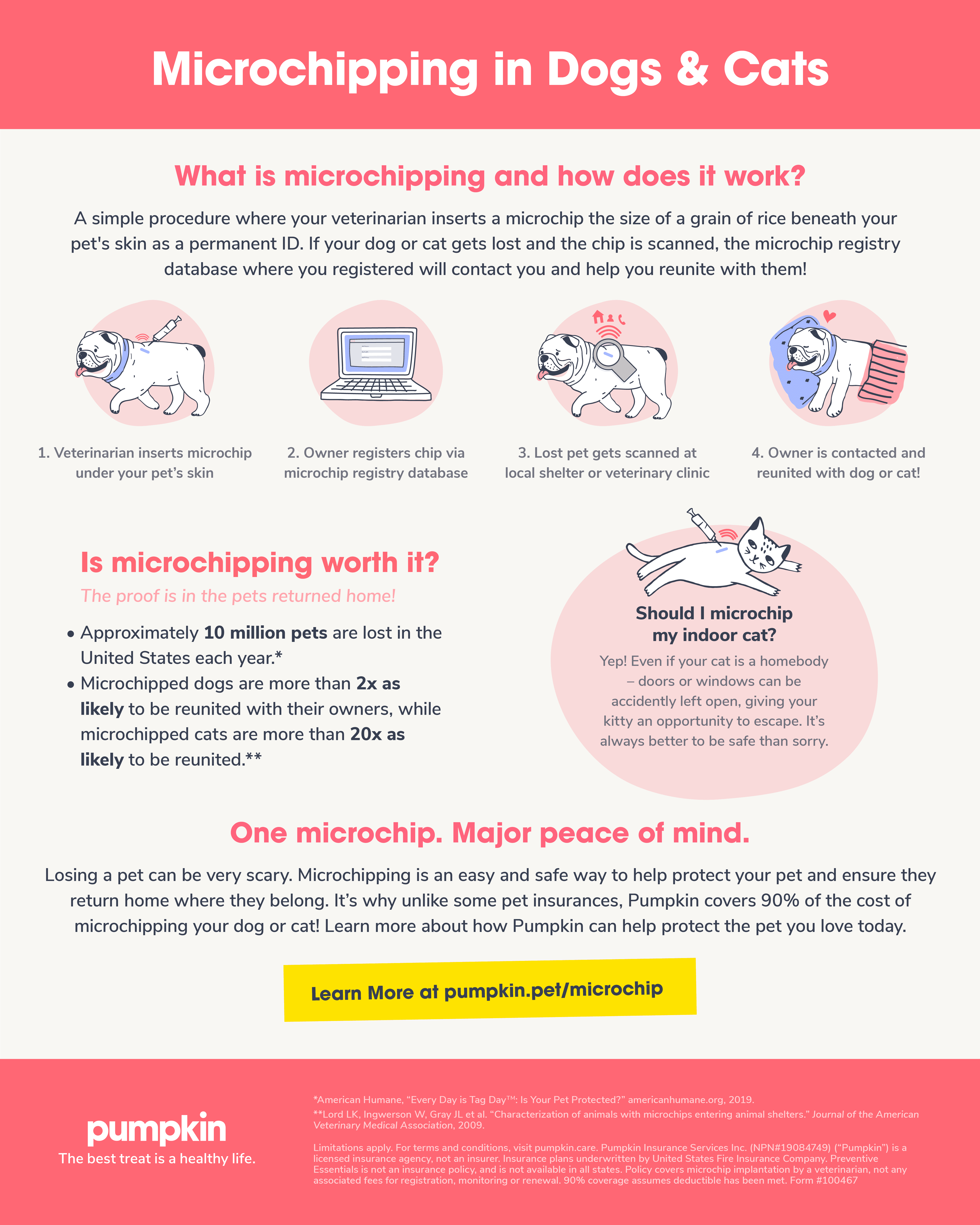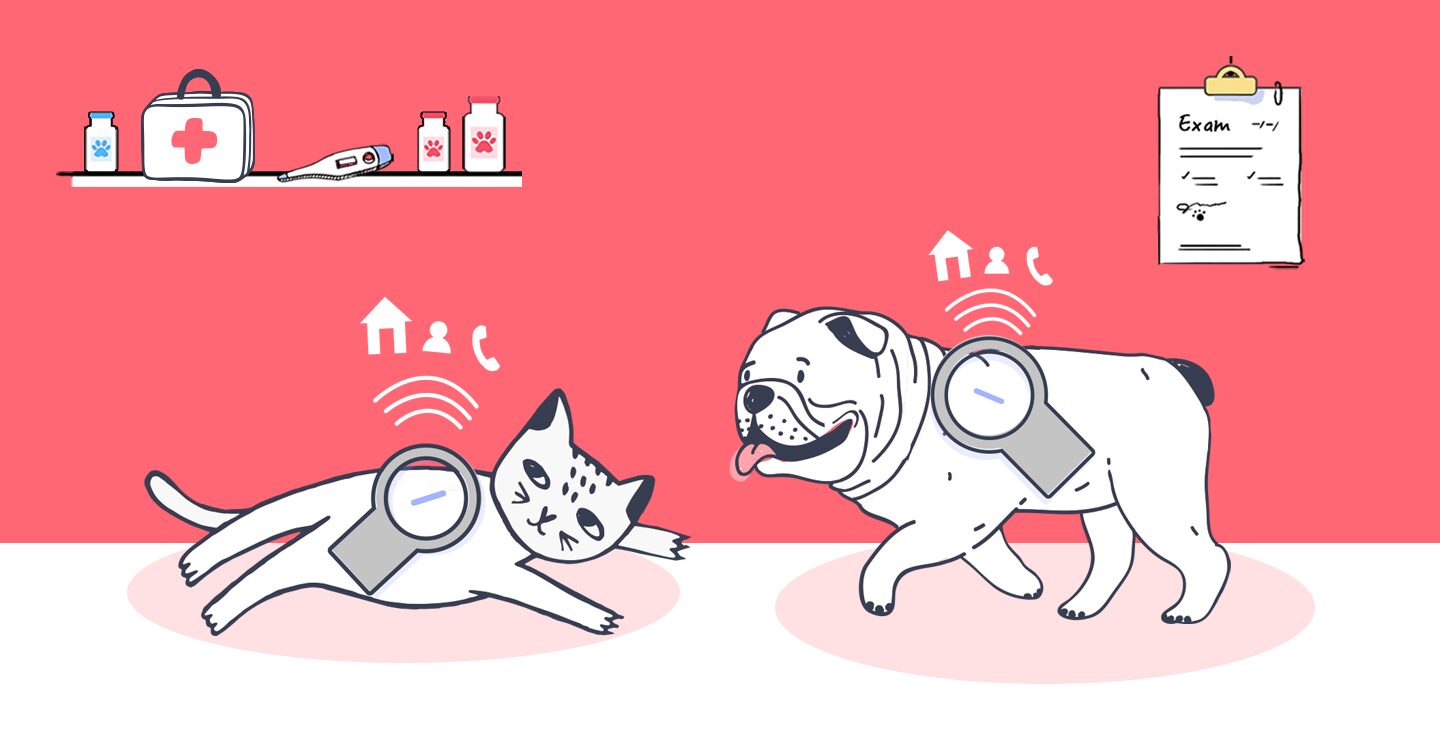More than 10 million pets go missing every year, according to an estimate from American Humane. Sadly, only about 15% of dogs and 2% of cats that end up in animal shelters without microchips or ID tags are reunited with their owners.
If you’re reading this, you’re probably a pet owner. Perhaps your furry friend is snuggled up beside you right now – dreaming about their next romp through the neighborhood. If so, reading the above statistics may have been unsettling. Fortunately, there’s an easy way to avoid contributing to those numbers. Microchipping in dogs and cats is a safe and effective way to find your pet should they ever get lost.
What Is Microchipping?
Microchipping in pets is a simple procedure where a veterinarian inserts a tiny microchip underneath the pet’s skin. The microchip itself is a small-scale radio transponder that carries a unique reference or identification number specific to your pet. The device is no larger than the size of a grain of rice, making it completely undetectable by you or your pet without special equipment.
Once you’ve microchipped your pet, you will receive instructions on how to register your microchip and address with a reputable microchip registry database, like one of these:
- Home Again
- PetKey
- AKC Reunite
- Free Pet Microchip Registry
- Found Animals
- AVID
- PetLink
- 24PetWatch
- Homeward Bound Pet
- BeKind PetFind
- SmartTag
According to a study published in the Journal of the American Veterinary Medical Association (JAVMA), only about 58% of microchipped pets were registered when animal shelters attempted to locate their pet owners, leading to many missed opportunities of reuniting lost pets with their owners. For all these reasons, it is absolutely crucial to register your pet’s microchip with a registry database!
While microchipping is a great safety net, using a microchip in conjunction with other identification measures – like an identification tag on their collar – is the best way to ensure your pet can find their way home safely.
The Microchipping Procedure
Microchipping is a quick procedure that can be performed by any licensed veterinarian. The microchip, no larger than 12mm in length, is injected between the shoulder blades just under your pet’s skin. The device can even be inserted during a regular check-up, using a needle that is slightly a larger gauge than one used for vaccinations. If you feel like your pet is particularly skittish or easily spooked, the procedure can be added to an already scheduled spay/neuter procedure or dental cleaning.
Does it Hurt?
Every animal is different. Some will be distracted enough to not even notice the microchip being inserted, while others may feel a little discomfort. It’s important to remember that thousands of microchips are inserted into cats and dogs every day – and the majority of these routine procedures are performed without a hiccup, even while the pet is awake.
Of course, your fur friend can’t tell you if they felt the procedure, but many pets demonstrate no physical reaction during microchipping. We do know that microchipping hurts no more than a shot, and since your pet has likely already received vaccinations in their lifetime -– there should be no surprises come microchipping time!
Most veterinarians also have tips and tricks for how to keep pets as calm and comfortable as possible during the procedure. Pumpkin’s resident veterinarian, Dr. Stacy Johnson, shared one of her tips with us: “For vaccinations, nail trims, and microchipping, I like to practice the ‘art of distraction.’ For instance, I often have my food-motivated patients munch on a mix kibble and treats during these procedures, making them almost unnoticeable! For this reason, I always recommend bringing your pet’s favorites to the appointment.”
While Dr. Johnson also noted that some pets will feel the vaccine-like insertion of the microchip, she doesn’t believe this should deter pet owners. “As someone who has experienced the joy of reuniting families with their pets – this simple procedure is definitely worthwhile!”
How Do Microchips Work?
Electronic microchips emit a unique sequence of radio waves when scanned, and – after registration – that transmission can be used to identify the missing pet and determine the contact information of the owner (like an email or phone number). Each microchip has a different signature, kind of like a unique barcode for your fur friend. The chip itself has no power source; it simply stores a code that waits to be read by a scanner. You can learn more about Radio Frequency Identification (RFID) here.
Keep in mind, to properly ID a lost pet, the microchip and microchip scanner need to be in proper working order and the registry in the chosen national database must be accurate. The majority of dogs and cats that are microchipped but not returned to their owners are a product of an inaccurate or outdated registry.
What Is the ISO Standard?
If you’ve been in the market for a microchip for more than just the last few minutes, you may have come across something called the “ISO standard.” But what does this ominous-sounding term mean? Fortunately, the ISO standard serves as an effort to create an identification system that can be recognized by scanners around the world.
In the past, your pet’s microchip may have emitted a different frequency than the microchip implanted in your neighbor’s pet. That means a scanner that only recognizes a specific frequency might be able to ID one cat or dog and not another. Clearly, this is an issue. Today – thanks to the ISO standard – should a pet tagging along on an international vacation get lost and end up in a local shelter, they can still find their way home.
Pro tip: If you’re traveling internationally or to an island destination with a new pet, Dr. Johnson recommends microchipping first, and then having your pet vaccinated for rabies. “When traveling to locations like Hawaii, you may need a rabies titer blood test and proof of identification, which actually is your pet’s microchip!”
Pet Pro Tip: Any responsible pet owner should seriously consider pet insurance. Properly understanding how Dog insurance works and Dog insurance covers can help you make an informed decision about your pet’s health needs and plan your finances accordingly!
Common Microchipping Myths
Pet owners sometimes think of microchipping as a foolproof way to find their pet at the drop of a hat. Scientists, however, have not yet produced a GPS device that’s safe to insert into your living pet. Moreover, almost all localization services require a battery-powered device, adding to the logistical concerns.
There are, however, GPS tracking devices that you can attach to your pet’s collar. The best pet trackers on the market cost anywhere from $70 to $150 and even include additional features like health tracking and heart rate monitoring. Again, these all require a battery and will need to be regularly charged – which makes microchipping still the best way to find your missing pet after the battery runs out.
Do Microchips Have Side Effects?
In extremely rare circumstances, the technology supporting microchips can fail. One study shows that less than half of 1% of microchips are deemed ineffective. Still, most of these lapses in performance are caused by older models with technology incompatible with modern scanners – and new universal scanners can read nearly any radio frequency, leaving even less room for error.
We know your primary concern is the safety of your pet. According to PetMD, microchipping your dog or cat is one of the safest and most routinely performed procedures your pet can receive. Out of the millions of microchipped cats and dogs, there are only a few cases with complications worth noting.
While there is anecdotal evidence of cancerous tumours appearing at the site of the insertion, there’s no evidence that microchips should be considered a causal factor. When it comes to microchipping, the benefits far outweigh the risks.
Can You Remove a Microchip?
Yes, a chip can be removed from a microchipped cat or dog in rare circumstances. Although, microchips are a little peskier to take out than they are to put in since they require a surgical procedure. A veterinarian will likely decline to remove a microchip unless there is a significant concern regarding your pet’s health. It’s also illegal for anyone besides the animal’s owner to request a microchip removal, so don’t worry about someone removing your pet’s microchip without your permission.
Is Microchipping Your Dog or Cat Worth it?
It may be easy to weigh the pros and cons of microchipping your pet now, but turning back the clock is impossible if they go missing.
Consider this: Dogs in animal shelters without a microchip are returned to their owners about 22% of the time, while microchipped dogs find their families 52% of the time. The statistics for cats are even more extreme. Cats in animal shelters without microchips are only returned to their owners 2% of the time, while microchipped cats find their way home close to 38% of the time, according to a study published by the JAVMA.
According to AKC Reunite, pets with microchips are up to 20 times more likely to be reconnected with their owners if they go missing. The data is clear: microchipping your dog or cat significantly increases the chances of being reunited should they run away or take a wrong turn. But are there any downsides to microchipping your pet?
If you’re a new pet owner and want to ensure a safe and happy home for them, don’t forget to take a look at our new puppy checklist and new kitten checklist for more tips!
If My Cat Never Goes Outdoors, Do They Still Need a Microchip?
As stated above, microchipped cats are more likely to be returned home in the event that they get loose. Cat owners might feel that if their cat remains indoors most of the time, or all of the time, that a microchip is unnecessary. The short answer to whether or not you should microchip your indoor cat is yes.
According to Veterinary Centers of America, even the most responsible cat owners cannot ensure their cat will never get lost. Situations presenting escape opportunities, like a door accidentally being left open or your cat pushing through a loose window, can occur at any time.
Additionally, indoor cats are unfamiliar with their outside environment, making it even more difficult for them to find their way back home should they get out. They will also be more frightened and anxious about being in the outside world, which can be very traumatic.
In any case, it’s better to be safe than sorry, so indoor cat owners should seriously consider getting their feline friend chipped.
Where Can I Buy a Microchip?
You can buy your pet’s microchip at your local veterinary clinic at the same time they perform the procedure. Most clinics have their preferred microchip companies, so the microchip you buy will likely be one that your veterinarian trusts and regularly carries at their clinic. While we recommend going this route, there are also a number of providers and retailers where pet owners can buy microchips directly. These are the top five microchips on the market today:
- Schering-Plough by Home Again
- 24 Pet Watch by Allflex
- ResQ by Bayer
- AKC-CAR by Trovan
- The Friendchip by Avid
Pro Tip: Avoid home kits or anything that asks you to insert microchips on your own – it’s best to let a licensed veterinary professional take care of the procedure to prevent an error or an injury.
How Much Do Microchips Cost?
Microchipping is not only safe, it’s also a cost-effective way to ensure your pet’s safety. Most microchips cost between $25 and $75, including registration in a nationally recognized database. However, with the right pet insurance, you may be covered for the entire procedure! In addition to extensive coverage for pet accidents & illnesses, Pumpkin covers 90% of the cost of microchip implantation by a veterinarian. Request a free quote today to find out other ways Pumpkin Pet Insurance can help protect your dog or cat for life.
In the end, the benefits of microchipping your pet far outweigh any hesitations or concerns pet owners may have about the process. Aside from being an important safety measure to take, microchipping provides peace of mind that if your best fur friend ever went missing – they’d have the best possible shot of making their way back home to you.
Download Our Pet Microchipping Guide





